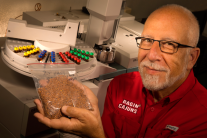Hasenstein sends radishes to space, again
Tue, 09/29/2020 - 4:13pmKarl Hasenstein of our biology department is sending radish seeds to the International Space Station again. The experiment is part of NASA’s quest to develop ways to produce nutritious vegetables in space to sustain astronauts during long missions.
The seeds will travel to the space station aboard a Cygnus spacecraft launched by an Antares rocket on Thursday, Oct. 1. The craft will carry supplies, equipment and scientific experiments. Blast off is scheduled for 8:38 p.m. EDT from NASA’s Wallops Flight Facility in Virginia. Once the seeds arrive, astronauts will place them inside an artificial environment called an Advanced Plant Habitat. The enclosed apparatus will enable scientists to study the radishes as they grow in altered gravity, and different atmospheric, light and soil conditions. The radishes will be cultivated for four weeks, the growth period for the plant. Hasenstein’s ongoing research is funded with a $573,000 grant NASA awarded in 2017.
The crunchy vegetables are well suited for researching galactic gardening, he explained. “They are fast growers, and the longer it takes a plant to grow in space before it can be harvested, the greater the potential for things to go wrong. Replicating nature isn’t easy.” Figuring out how to reliably grow crops inside a tiny, human-made environment some 240 miles above Earth carries “an enormous learning curve,” Hasenstein said. The habitat is 18 inches square and enables plants to reach a height of 16 inches. “It’s a very intricate system. It doesn’t tell you it dispensed 5 milliliters of water, for example. It tells you something like it activated 300 clicks to dispense a certain amount of water. So you have to translate what it all means,” he said. Four batches of 20 radishes will be grown as part of Hasenstein’s research. Astronauts will monitor two batches aboard the station; another two batches will be grown at the Kennedy Space Center in Cape Canaveral, Florida. Based on photos taken by the artificial habitat’s camera that are downloaded to Earth daily, Hasenstein will control experiment parameters.
NASA’s plan to discover methods for growing vegetables in space is part of a larger effort. The space agency hopes to put scientists on Mars as soon as 2030. Establishing human colonies on the inhospitable Red Planet, some 50 million miles away, hinges on many factors.
Hasentein is doing his part to make human existence on Mars possible. In 2017, Hasenstein sent radishes to the space station to explore ways altered or reduced gravity affects plants’ growth and metabolism. In 2014, an experiment aboard the station examined how Brassica rapa plants, of which turnips are a subspecies, sense and react to gravity in a weightless environment.
Each of Hasenstein’s experiments adds to a growing body of knowledge for cultivating vegetables in space, he explained. “Radishes, cabbages, turnips, and broccoli are all from the same family, and contain similar compounds. So, when we get data on one, we can make extrapolations about the others.” Hasenstein isn’t sure when his latest project will return to Earth. The first batch of radishes is tentatively scheduled to return in late December. No date has been established to send the second batch home. When they do return, Hasenstein will retrieve the plants from the Kennedy Space Center.
A team of University scientists, including undergraduate and graduate students, will then conduct exhaustive laboratory research. They will analyze growth rates, genetic profiles, mineral uptake, nutrient content, metabolic and physiological responses, and many other variables. The research will be compare compared to data collected from experiments on the ground.
Hasenstein is optimistic he’ll also get input from an important group of food critics. “Hopefully, we can grow enough quality radishes to say, ‘Hey, astronaut, are you ready to chomp on some space produce?’” he said with a laugh.
Learn more about the mission to the International Space Station and how to watch Thursday’s scheduled NASA launch.
Photo caption: Dr. Karl Hasenstein, professor of biology at the University of Louisiana at Lafayette, is sending a crop of radishes to the International Space Station. The vegetables will travel aboard a craft scheduled to be launched Thursday, Oct. 1, from NASA’s Wallops Flight Facility in Virginia. Hasenstein’s research is helping the space agency research methods for growing vegetables in space to sustain astronauts during long missions. Photo credit: Doug Dugas / University of Louisiana at Lafayette

